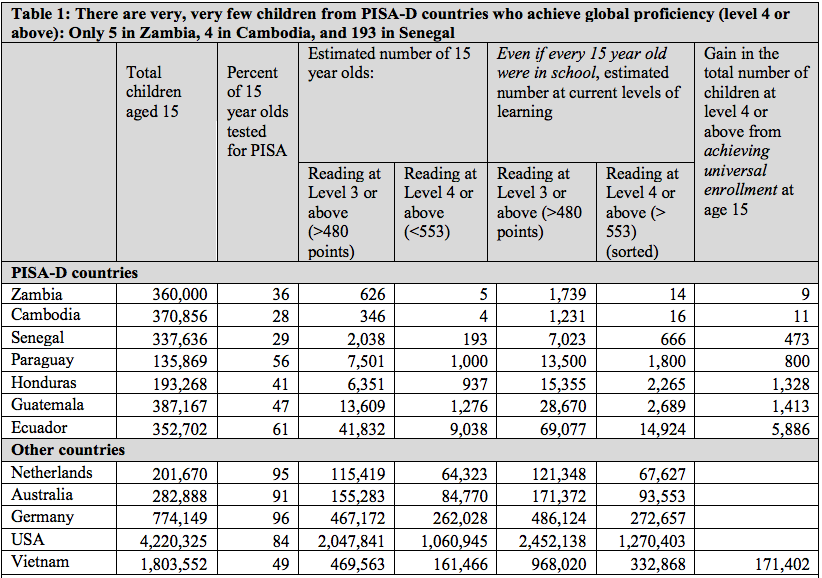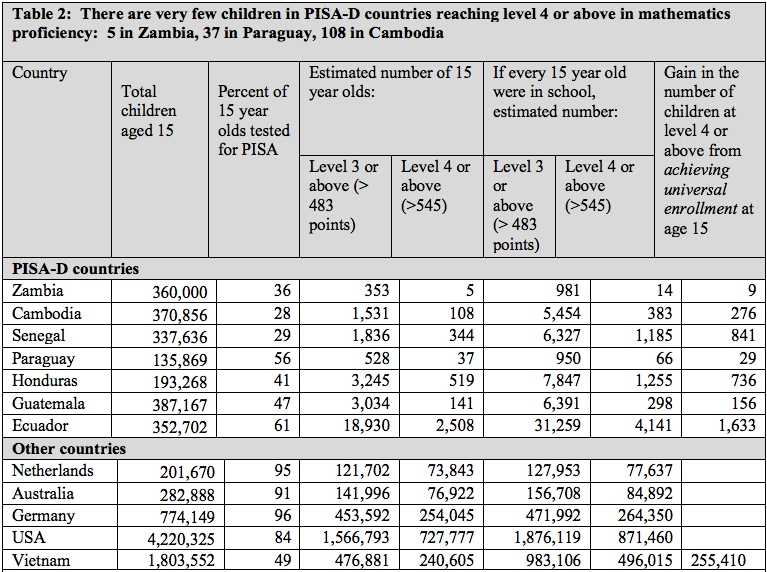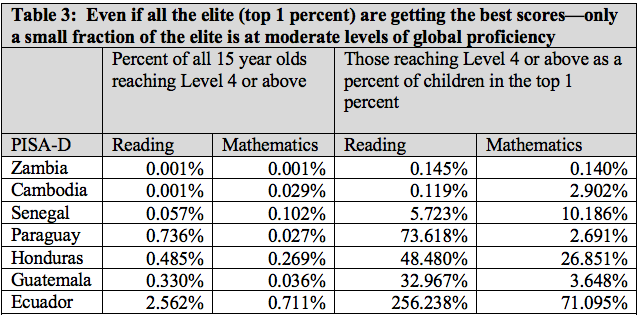Lant Pritchett
Blavatnik School of Government, University of Oxford
Blog
Recently released results from PISA-D reveal that even middle class and “statistical elites” are not escaping the learning crisis as weak systems fail to deliver adequate learning, even to the relatively privileged children.
The learning crisis, that many children in school are learning too little, has been well documented with a variety of sources: ASER in India and its variants on citizen surveys in other countries, the DHS has added a simple reading assessment, and some developing countries have participated in international and regional assessments. Since both better learning performance and equity start with “raising the floor,” the fact that many students are not reaching even minimum proficiencies of literacy and numeracy—many of whom are from poorer, disadvantaged, and marginalized households and groups—are major concerns.
But the recently released results from the initial round of PISA for Development (PISA-D) for the six pioneering countries that took part reveal there is a learning crisis at the top, too. The middle class and “statistical elites” are not escaping the miasma of poor education systems. Weak systems are failing to deliver adequate learning, even to the relatively privileged children.
In Table 1, I use the results of PISA-D to estimate how many children in absolute numbers from the six participating countries reach higher levels of performance on PISA-D reading. I estimate the absolute number of children at Level 3 or above and Level 4 or above. Level 3 includes the normed mean score of 500 (the average of the OECD countries), and about 30 percent of OECD 15-year-olds are at Level 4 or above. I refer to these levels—the range slightly above and below the average in the OECD—as “global medium proficiency” (Level 3 and above) and “global proficiency” (Level 4 and above).
Australia has roughly the same estimated number of 15-year-olds as many of the PISA-D countries: 282,888. In Australia, there are about 85,000 fifteen-year-old students at Level 4 or above. In Zambia, which has 360,000 fifteen-year-olds, the estimate is that there are 5 children at or above Level 4. Not 5 percent, or 5 thousand, or 5 hundred, but 5. As in the number of fingers on just your left hand, five. In Cambodia, the estimate is that there are only four. Even in the countries with slightly higher performance, in all but Ecuador, there are less than 1,300 total 15-year-olds scoring at even these modest levels of proficiency in reading.

Note: Estimates of the number of top performers assume that PISA-D school sampling frame included all top performing schools. The PISA-D school target populations and sampling frames were set by National Project Managers. For more details see the PISA-D Technical Report Chapter 4 which covers sampling.
Source: Author’s calculations with PISA-D results.
Table 2 shows the same calculations for mathematics. Australia has 76,922 fifteen-year-olds at Level 4 or above, the Netherlands roughly 74,000. Again, Zambia has only five children above this threshold. Most of the other countries do worse on mathematics than in reading: Guatemala had 1,276 who could read at Level 4 or above, but only 141 at Level 4 or above in mathematics. Ecuador had 9,038 fifteen-year-olds at Level 4 or above in reading, but only 2,508 for mathematics.

Note: Estimates of the number of top performers assume that PISA-D school sampling frame included all top performing schools. The PISA-D school target populations and sampling frames were set by National Project Managers. For more details see the PISA-D Technical Report Chapter 4 which covers sampling.
Source: Author’s calculations with PISA-D results.
We don’t want to take these numbers too literally and imbue them with more precision than they really have. These estimates are based on nationally representative samples and there are almost certainly elite schools in these countries that may have a few hundred students that weren’t in the sample frame or didn’t happen to get sampled. I am not trying to emphasize that there are just 5 children in Zambia at Level 4 and above, and that Paraguay with 37 or Guatemala with 141 is doing much better. I am emphasizing that all these countries (with the possible exception of Ecuador, which is both a richer country and has had an extensive reform of education over the last decade) have so extraordinarily few students, not just in the “global elite” or super-stars of performance (say, Level 6 or top 10 percent), but even globally medium proficient or globally proficient.
Think of the high-level skills and national leadership these countries need to meet the many challenges they face and to develop their national societies and economies. These countries need engineers, doctors and nurses, entrepreneurs, government officials and policy makers, university professors, and politicians and political leaders. In a country like Zambia, these all have to emerge from a system of basic education producing five students a year with reading and math skills at global proficiency levels (compared to the tens or hundreds of thousands other countries can draw from). In Honduras, there are less than 1,000 students at global proficiency levels in reading or math. These countries could not fill the entering class of even single modest sized university with students in the global top 30 percent.
And Vietnam proves these low levels of performance are not an inevitable condition of being a developing country. In Vietnam, there are 240,605 fifteen-year-olds at Level 4 or above in math and 161,466 at Level 4 or above in reading. For every child in Cambodia that is globally proficient in math, there are 2,200 such children in Vietnam.
With learning levels this low, expanding enrollment will do some good, but will not raise the absolute number of students who are globally proficient by much. PISA-D only tests those aged 15 who are in Grade 7 or higher. In Zambia, this meant only 36 percent of those aged 15 were tested. But suppose we just take the fraction who did achieve at Level 4 or above in mathematics and multiply that times the entire 15-year-old population—a crude simulation of the gains from reaching universal enrollment at current learning profiles. The number performing at Level 4 or above would increase from 5 to 14. Expanding the number of children who reach Grade 7 or higher by age 15 by more than 230,000 children, would result in only 9 more children across the whole country able to perform at modest global levels. Even in other countries (besides Ecuador) universalizing education to age 15 would add less than 1,000 new students at global proficiency in mathematics and less than 2,000 in reading. Even if Guatemala pushed from only 47 percent in school at Grade 7 or above to 100 percent, this would add 156 additional 15-year-olds at Level 4 or above for a total of 298.
Vietnam, in contrast, tested only about half of 15-year-olds, if they could universalize and maintain their same learning profiles they would add half a million more children globally proficient in mathematics.
In these countries and others like them, the learning crisis doesn’t mean that “the poor” and disadvantaged are getting a bad education and “the rich” are getting a good education. It is worse than that. The “rich” (in a statistical sense of the upper tail) are getting a globally inadequate education and the poor and disadvantaged are not getting much education at all.
Table 3 shows that, even if we assume that all of the top performers come from the top 1 percent by some measure of socio-economic status, it is still the case in most of the countries that (except in Ecuador) less than half of the economic “elite” (top 1 percent) are getting an education that reaches global proficiency. The empirical logic is pretty straightforward. Suppose that, as in Honduras, only half of 1 percent of all 15-year-olds are reaching Level 4 in reading, then, even if all of those were from the 1 percent, this is still only 48 percent of the 1 percent that reaches global proficiency. In low performing countries like Senegal, this means that less than 1 in 10 children of the “elite” 1 percent (however ranked) is reaching a standard of global proficiency in reading or math—a level reached by over 20 percent of children in Vietnam.

Source: Author’s calculations with PISA-D results
The challenge in some countries is inclusion—getting marginalized children into a system that is already working for most. But in many countries, the challenge is that the education system is not producing high-quality learning, even for the elite. There isn’t a functional educational system that is coherent around producing high-quality learning outcomes that anyone can be “included” into. In these cases, the urgency is to both universalize minimum proficiency and improve learning for everyone, at all levels.
Some of the gains of education within a given country might be relative or positional so that just being at the top of local performance, no matter how low, brings access to good jobs and status. But, in an increasingly global world, country elites cannot be complacent about being the one-eyed in the kingdom of the blind. Countries need to address the learning crisis by raising the floor, but there is a learning crisis at the top, too.
For more analysis of the PISA-D results, see Michelle Kaffenberger’s recent blog “PISA-D Results Reveal Shockingly Low Learning Levels”.
RISE blog posts and podcasts reflect the views of the authors and do not necessarily represent the views of the organisation or our funders.